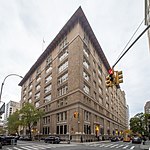The Players (often inaccurately called The Players Club) is a private social club founded in New York City by the noted 19th-century Shakespearean actor Edwin Booth.
In 1888, Booth purchased an 1847 mansion at 16 Gramercy Park, reserved an upper floor for his residence, and turned the rest into a clubhouse. The building's interior and part of its exterior were designed by architect Stanford White; its entryway gaslights are among the few remaining examples in New York City. It is reportedly the oldest club in its original clubhouse and was named a National Historic Landmark in 1962.The Players serves as a social club but is also a repository of American and British theatre history, memorabilia, and theatrical artifacts. It has been reported to have the largest private collection of stage memorabilia, including costumes and weaponry, and owns portraits of its members, most notably a portrait of actor Joseph Jefferson painted by John Singer Sargent. A portrait of John Wilkes Booth, the assassin of Abraham Lincoln, hangs in Edwin Booth's suite, along with the letter Edwin wrote to the public apologizing for the actions of his brother.Today, the club still holds "Pipe Nights" honoring theatrical notables, and maintains a kitchen and wine cellar and a billiard table in its usually busy Grill Room. In the Dining Room, filled with portraits of theatre and film notables and rare playbills from the 19th and 20th centuries, a small stage has been built where members and people of the theatre can be honored; staged readings can take place and new works tried out.
The Players also gives the prestigious "Edwin Booth Life Achievement Award" to actors who have had a long, important body of theatre and film work. Past recipients include Helen Hayes, José Ferrer, Garson Kanin, Christopher Plummer, Jason Robards, Jack Lemmon, and Marian Seldes. In June 2007, Angela Lansbury was the recipient, and Edward Albee received it on September 30, 2007.










